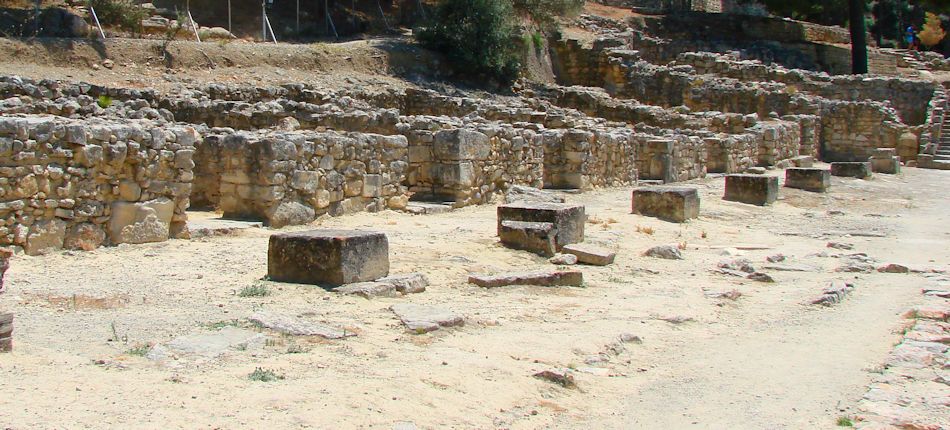
Agia Triada arcaeological site
Four kilometers west from Phaistos are the ruins of the Royal Villa, the Small Minoan Palace at Agia Triada. The site is named after the village of Agia Triada that is located next to it and was inhabited untill 1.897, when the Turks destroyed it. The Minoan name of the site is unknown .
At the site are the Minoan town, the palace and the tombs, excavated by Halbherr with L. Banti in 1902 and onwards. La Rosa resumed the excavation after 1976.
History
Remains of a settlement and graves prove that the site was inhabited as early as the 3rd millennium B.C. In 2600-1700 B.C., the time of the heyday of the first (old) palace at Phaistos, only small building were erected in the area of the Royal Villa. The villa was built in ca. 1600 B.C. and destroyed sometime in the 15th century. An imposing "megaron" of the "Mycenaean" type was erected on its ruins (14th-11th centuries B.C.) and an extensive settlement with a portico ("agora" or market-place) developed to the north of the villa.
In the Geometric period (8th century B.C.) the site was a cult place, while in the Hellenistic period (4th-1st century B.C.) a small sanctuary was founded, dedicated to Zeus Velchanos. The single-aisled church of St. George was built in the period of the Venetian occupation (14th century A.D.).
Aghia Triada was first investigated in 1902, in the course of excavations at the neighbouring site of Phaistos. Systematic excavations were begun in 1903 and completed in 1914. Work was resumed recently in the area to the north of the Mycenaean settlement, by the Italian Archaeological School at Athens (directed by Vnicenzo La Rosa).
The central part of the Villa is protected under a shed. The rest of the monuments have been cleared and consolidated.
Photos
Monuments
The most important monuments of the site are:
 The Royal Villa.
The Royal Villa. It consists of two wings and, although it was smaller than the palaces of Knossos and Phaistos, it presents all the typical features of palatial architecture: halls with polythyra (pier-and-door partitions) and a light-well, shrines, magazines, repositories, workshops, staircases, porticoes, courtyards, terraces, balconies and paved streets.
The settlement and "Agora". They lie to the NE of the villa and belong to the Mycenaean period. Eight spacious rooms are opened behind the portico of the Agora (market-place) while to the west of it are the remains of a Mycenaean settlement.
The cemetery of Aghia Triada. It includes two Early Minoan (3000-2300 B.C.) tholos tombs with complexes of funerary rooms, and chamber tombs of the Late Minoan period (14th century B.C.). Burials were placed in clay larnakes (sarcophagi). A similar larnax, made of limestone, the famous painted sarcophagus of Aghia Triada, was also found at this cemetery.
The "Megaron" of the "Mycenaean" type, built over the storerooms of the Royal Villa, is contemporary with the portico.
Church of St. George Galatas. The Byzantine church, decorated with splendid wall-paintings, lies in the courtyard of the Minoan villa.
Findings
Some of the most important findings of the Minoan period were excavated in Agia Triada and are currently on display at the Archaeological museum of Iraklion. These include three engraved clay vessels of exemplary artistic value and the famous sarcophagus the only stone sarcophagus ever to have been found in Crete.
more on findigs from Agia Triada
In and around Show All Tourism facilities Regional interest Towns & Villages Sightseeing Beaches PhaistosPalace and Archaeological Site at 2.1km (SE)
|